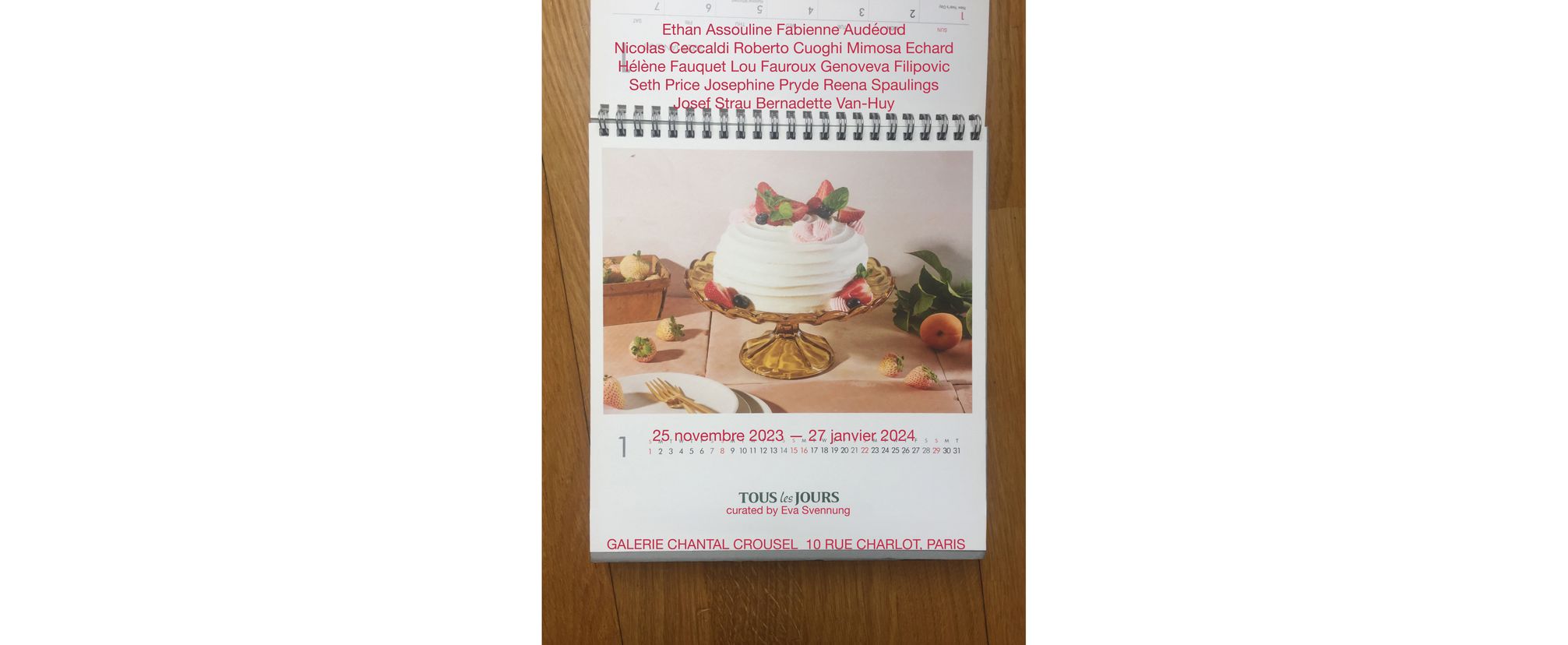Galerie Chantal Crousel presents "Courbet your enthusiasm", Reena Spaulings’ first solo exhibition in Paris.
In 2004, the New York-based artist Reena Spaulings emerged from within the daily operation of an art gallery, Reena Spaulings Fine Art, on Manhattan’s Lower East Side. Often playing on the double-identity of art dealer and artist, Spaulings’ work undermines professional divisions of labor while interrogating accepted notions of authorship and artistic agency.
Among other new works, "Courbet your enthusiasm" includes pointillist paintings of the New Museum in New York, natures mortes, light boxes of art dealers and racecar drivers, screen prints based on existing artworks, postcards of heads and unmanned aerial drones, a flag, and a series of Enigmas (tablecloths taken from art world dinners, stretched like paintings).
The Enigma that materializes in the midst of a gallery or museum dinner is a sign of our non-stop activity, an image that emerges directly from the regular, quasi-festive gatherings of the creative class, in New York and elsewhere (a post-Fordist painting, according to Paolo Virno’s words). Like money, it is a real abstraction. And like any artwork, it also happens to be the work of multiple authors, including dealers, curators, writers and collectors. A new series of Enigmas replaces or takes over for Wade Guyton’s inkjet monochromes, which decorated Galerie Chantal Crousel’s walls last month. Guyton’s black floor, on the other hand, has been put back to work.
When work that is normally unseen or unsigned becomes strangely conscious of itself and of its function within the context of contemporary art, we are getting closer to "Courbet your enthusiasm". Here, the specific job of the artist is sometimes displaced in relation to activities such as art handling, shipping, publicity and the ongoing production of a gallery archive.
Recent solo shows (selection):
Contemporary Art museum, Saint Louis (USA), from September 2008; "How To Cook a Wolf", Kunsthalle Zurich, Zurich, 2007; "Bialystoker", Sutton Lane, London, 2006.
Recent group shows (selection):
"Painting: Now and Forever, Part II", Carol Greene and Matthew Marks, New York, Summer 2008; "L’argent", Le Plateau / Frac Ile-de-France, Paris, June-August 2008; "Some Neighbors", Kunstverein München, Munich, May 2008 ; "945 + 11", Frac-
Collection Aquitaine, Bordeaux, 2007; "Make Your Own Life", Museum of Contemporary Art, Miami, 2007.
Michael Krebber, about Courbet your enthusiasm :
To know who is what requires knowing who is who and what is what.
Step out, reflecting on reflecting upon.
Malice in Wonderland.
Contemporarily, the artist deals in recognizability and its payoff: recognition.
Recognizing in this case is reknowing what is known, which involves reseeing what can be.
Already there are too many problems.
Making one thing of many.
Geo. H. W. Bush and George Seurat both believed in points. And they both had a point.
When accounting for economy of scale, a brand new idea of a new idea is a dream.
After dinner planning the next dinner begins. Knives, forks and spoons are removed.
Can a mess be complete? Surely never completed. Not in one eternity. Only replete – such is logic in systematic argument.
Processing goes best when points are fixed without relation to a center.
The relative merits of doing something this way now means one can do it the other way, or another way next time. It’s a matter of living in and living out of the condition – the condition being: facing one way so as to not face another.
An allegory of value can be read out of crumbs fallen to the floor, swept up, in a clean sweep.
To sweep clean questions evidence organizing. The evidence is one thing, turning it into an argument is another.
Dealing with a set of concerns sometimes means dealing from the bottom, sometimes from the middle, sometimes from the top. Seconds, thirds, the perfect hand is the one that wins the game of the others.
The Winning in a competition of ideas in a fixed game is a zero–sum game.
Fight information with information.
Knowing data can be misrepresented amounts to a misunderstanding under a description.
Being one thing involves not being something else. Being two things involves being seen unambiguously to be both and neither.
Occasionally on has to take matters into one’s own hands.
The problem is: activity may actually lead to something in something resulting in a result as a result of results.
Paradox is only an impediment to truth when it leads to ambiguity.
The dealer’s dilemma is a function of thinking like a producer rather than a distributor.
Transforming use into value entails transforming value into use.
In an economy of function distribution of labour is decisive.
Being sufficiently vague is a precise business. The problem is related to humor – where there is nothing funny about making jokes.
How do you trade places with yourself?
The puzzling aspect of all things oracular is: how does the sphinx know?
The riddle of the sphinx is: how does the oracle know what not to say?
How can one thing be itself and something else at the same time?
It can’t.
One thing becomes another in being itself.
On some traditional views a dealer is one who is capable of talking out of both sides of their mouth, an artist one who is able only to speak directly.
To synthesize the two one would need to able to talk out of their ass.














